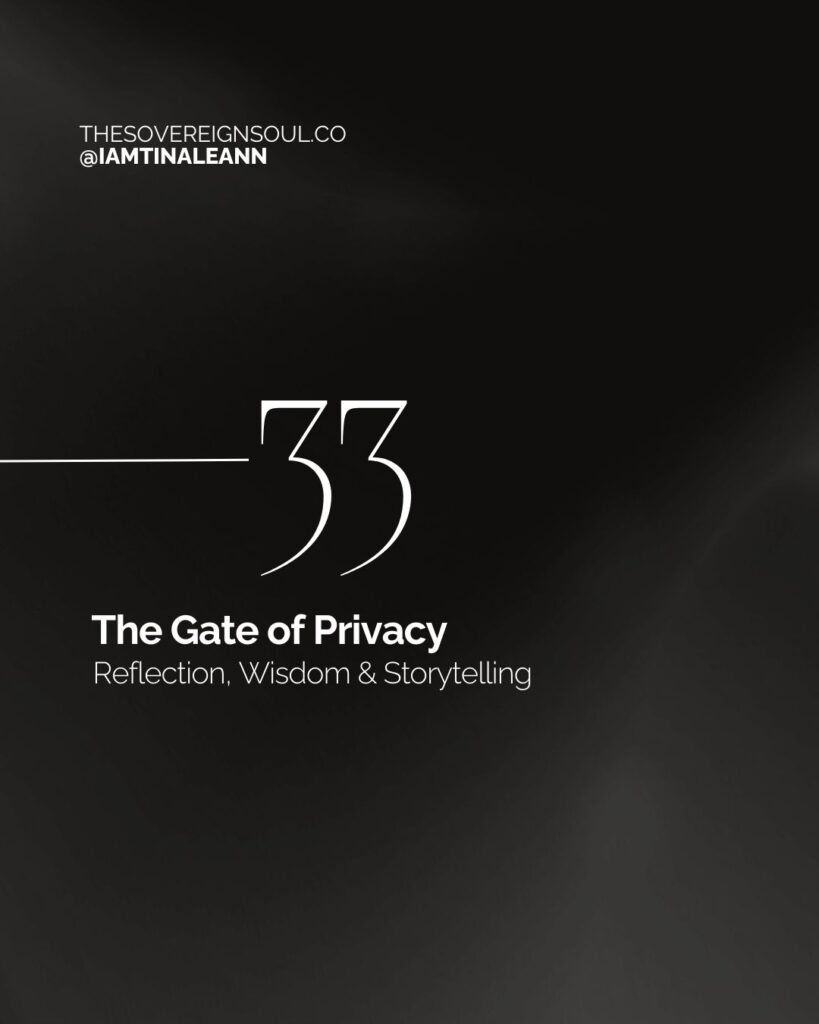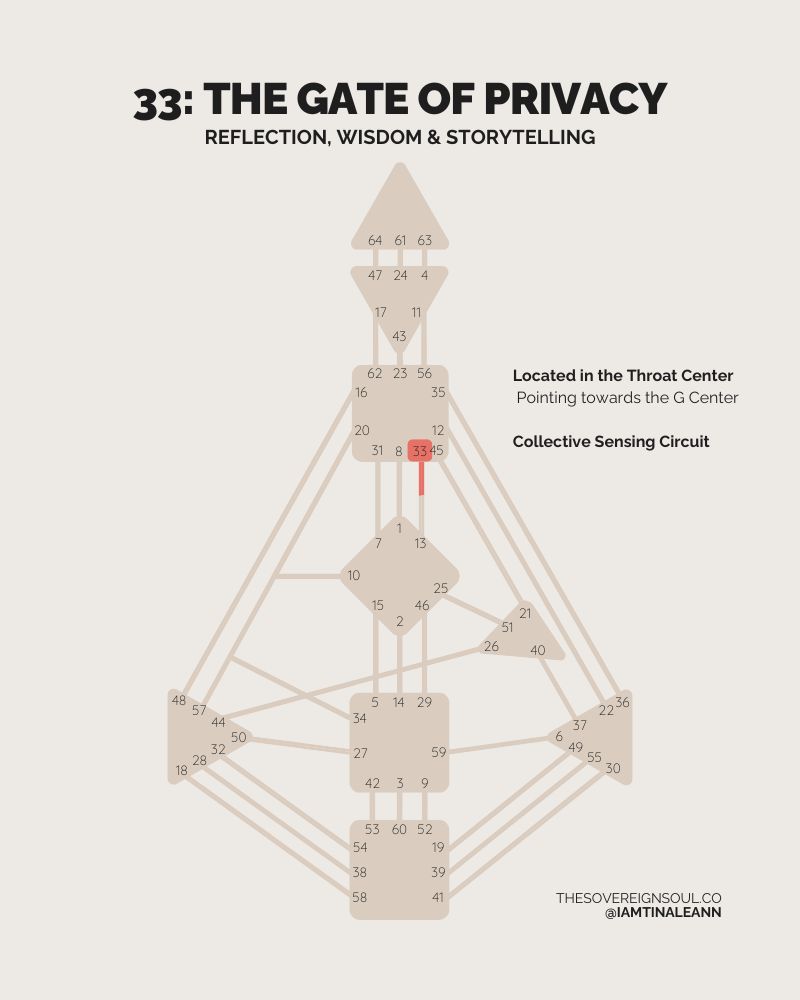Gate 33 in Human Design: The Gate of Retreat – Reflection, Wisdom & Storytelling
Do you feel the need to withdraw and process experiences before speaking? Do you instinctively know when it’s time to step back and reflect? Do you feel a deep connection to the past, understanding the importance of history and storytelling?
If so, you might be experiencing the energy of Gate 33 – The Gate of Retreat in Human Design.
This gate is all about stepping back, reflecting on life’s experiences, and sharing wisdom when the time is right. People with Gate 33 are natural observers and storytellers, but they must learn to trust their need for solitude before expressing what they’ve learned. Their challenge is balancing retreat with sharing—ensuring they don’t isolate themselves for too long or speak before they’re ready.
Gate 33 is located in the Throat Center, which governs communication, expression, and bringing experiences into words.
This gate is part of the 13-33 Channel (The Channel of the Prodigal) when connected to Gate 13 (The Gate of the Listener) in the G Center. Together, these gates create a powerful ability to absorb, process, and share life’s stories for the benefit of the collective.
Key Themes of Gate 33:
✅ The need for retreat—taking time away to process experiences.
✅ Reflecting on the past—learning from history, both personal and collective.
✅ The ability to tell powerful stories—turning life lessons into wisdom.
✅ The challenge of balancing solitude with sharing.
Gate 33 is part of the Collective Sensing Circuit, meaning its energy is focused on absorbing life experiences, making sense of them, and passing down wisdom for the benefit of all.
The Energy of Gate 33: Reflection, Wisdom & Storytelling
1. The Need for Retreat & Reflection
Gate 33 carries the natural urge to step back, observe, and process experiences before taking action.
🔹 Feels overwhelmed if constantly surrounded by noise and distractions.
🔹 Needs moments of solitude to process what they’ve seen and heard.
🔹 Finds clarity and insight when given space to reflect.
🔹 Can struggle when pressured to respond or speak before they’re ready.
✨ Ask yourself: Am I honoring my need for reflection, or am I feeling pressured to speak before I’m ready?
2. Holding & Releasing Stories
Because Gate 33 is deeply connected to storytelling and memory, it has a unique ability to take life’s experiences and translate them into meaningful lessons.
🔥 Absorbs the energy and stories of others—acts as a “keeper of wisdom.”
🔥 Knows when an experience is ready to be shared and when it needs more time.
🔥 Feels a strong pull to document or record history in some way.
🔥 Can feel burdened if holding onto too many stories without release.
💡 The key to working with Gate 33 is understanding that stories are meant to be processed and shared, not hoarded.
✨ Ask yourself: Am I allowing myself to express what I’ve learned, or am I holding onto experiences for too long?
3. Speaking Only When the Time is Right
People with Gate 33 have a deep awareness of timing—they know when to speak and when to remain silent.
💛 Not every moment is the right moment—wisdom lands best when people are ready to receive it.
💛 Trusting the process ensures that when they do speak, their words have impact.
💛 They don’t need to “fill the silence”—their words are most powerful when spoken with intention.
💛 The challenge is trusting themselves to share, rather than staying silent for too long.
💡 The key to mastering Gate 33 is realizing that wisdom only becomes valuable when it is shared with the right people, at the right time.
✨ Ask yourself: Am I holding back my insights out of fear, or am I trusting my intuitive timing?
The Shadow Side of Gate 33: Isolation & Holding on Too Long
Because Gate 33 feels the need to retreat and reflect, it can sometimes lead to:
❌ Withdrawing too much—avoiding social interactions out of overwhelm.
❌ Holding onto stories or experiences instead of letting them go.
❌ Feeling unheard—believing their wisdom isn’t valued or understood.
❌ Speaking too soon—sharing before they’ve fully processed what they’ve learned.
💡 The key to mastering Gate 33 is understanding that stories need to be shared at the right time—neither too soon nor too late.
✨ Ask yourself: Am I giving myself enough space to reflect, but also enough courage to share?
How to Work with Gate 33 Energy
💡 Honor Your Need for Solitude – Step back when you need to—your best insights come in moments of quiet.
💡 Let Go of Stories That No Longer Serve You – Not everything needs to be held onto—release what no longer aligns.
💡 Trust Your Timing – You know when the time is right to speak—don’t force or rush it.
💡 Document Your Insights – Writing, recording, or storytelling helps process experiences before sharing.
💡 Recognize That Your Words Carry Power – When you do speak, people listen—trust your impact.
The Gift of Gate 33
Gate 33 carries the energy of wisdom, reflection, and storytelling.
It teaches us that:
✅ Stepping back is necessary—wisdom emerges in moments of solitude.
✅ Life’s experiences are meant to be learned from and shared.
✅ Knowing when to speak is just as important as knowing what to say.
✅ The past holds valuable lessons—but we must process them before passing them on.
If you have this gate, your ability to retreat, reflect, and share wisdom is a powerful gift. Honor your need for quiet, trust your process, and remember that your words have the power to guide and heal.
So, the question is: Are you allowing yourself the space to reflect before sharing your wisdom, or are you feeling pressured to speak before you’re ready?
Feeling this energy? Drop a comment and share how Gate 33 shows up in your life!








